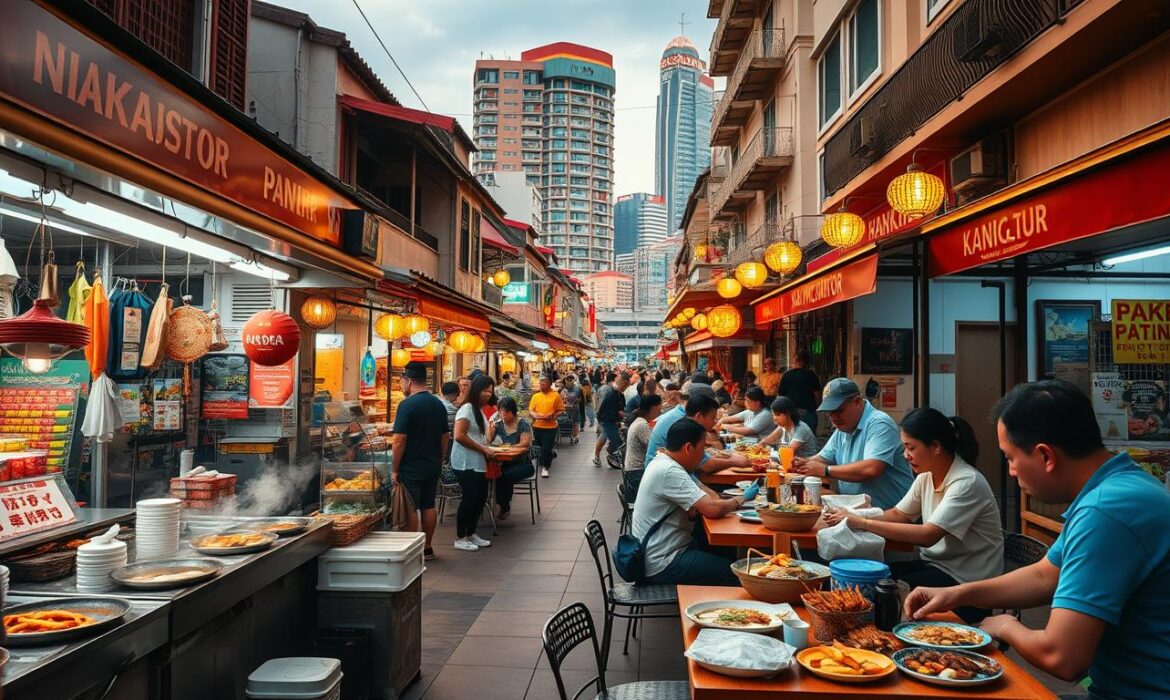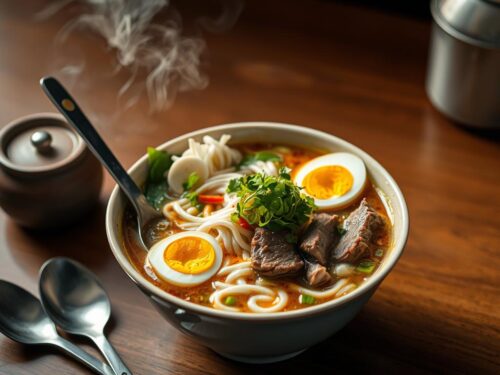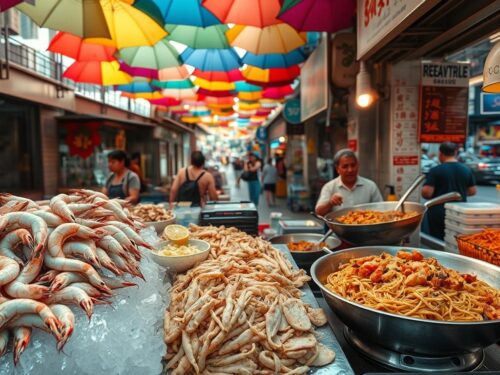Singapore is a paradise for food lovers, blending rich hawker traditions with world-class dining. From sizzling street food to elegant Michelin-starred spots, the city offers endless culinary adventures. Whether you crave chili crab or fragrant chicken rice, there’s something for every palate.
This guide highlights iconic eateries and hidden gems across budgets. Discover family-run stalls with decades-old recipes alongside modern kitchens pushing boundaries. Plan smartly—book ahead for popular spots or visit off-peak to skip long waits.
Ready to explore? Let’s dive into the vibrant food scene that makes this city unforgettable.
Key Takeaways
- Singapore blends hawker culture and fine dining for a unique food experience.
- Options range from budget-friendly stalls to high-end Michelin spots.
- Must-try dishes include chili crab and chicken rice.
- Reservations help secure seats at popular places.
- Timing visits avoids crowds at peak hours.
Introduction to Singapore’s Vibrant Food Scene
From plastic stools to polished silverware, Singapore’s dining scene dazzles with contrasts. The city thrives on its ability to blend humble street eats with haute cuisine, offering unforgettable flavors at every turn.
Why Singapore is a Food Lover’s Paradise
Imagine biting into crispy roti prata at dawn, then savoring a truffle-laced dish by sunset. Singapore’s food culture—shaped by Malay, Chinese, and Indian traditions—creates a tapestry of bold flavors. Every meal feels like a celebration.
Exploring Hawker Centers vs. Fine Dining
At hawker centers, masters spend decades perfecting one iconic dish, like char kway teow or laksa. These bustling hubs host 100+ stalls, each a testament to culinary dedication.
Meanwhile, spots like Odette and Zén redefine elegance with multi-course tasting menus. Yet even high-end kitchens, like Labyrinth, spotlight sustainability—using 90% local ingredients.
Whether cracking chili crab at a neon-lit stall or toasting with champagne at a Michelin-starred table, every experience here tells a story.
Best Local Restaurants in Singapore for Authentic Flavors
Culinary mastery shines at these iconic spots, where decades-old recipes meet modern techniques. Whether it’s the fiery kick of chili crab or the comforting warmth of chicken rice, these kitchens preserve Singapore’s food heritage with every dish.
Keng Eng Kee Seafood: A Chili Crab Legend
Pre-order their signature chili crab to experience a perfect balance of sweet, spicy, and tangy sauce. Regulars swear by pairing it with steamed buns to soak up every drop—though crispy mantou offers a delightful crunch alternative.
Don’t miss their coffee-glazed pork ribs, where bitter espresso notes cut through the caramelized richness. Featured on Netflix, this family-run spot proves that innovation thrives alongside tradition.
Tian Tian Hainanese Chicken Rice: A Must-Try
Since 1987, Tian Tian has perfected its chicken rice by poaching poultry in a precise 100°C master broth. The result? Silky meat that earned a victory over Gordon Ramsay in a televised cooking challenge.
Locals debate whether Maxwell Centre’s Ah Tai rivals Tian Tian—the former offers a lighter ginger accent, while Tian Tian’s rice absorbs more pandan fragrance. Try both to pick your favorite.
Hidden Gems in Singapore’s Hawker Centers
Beyond the well-trodden paths of Singapore’s food scene lie hidden culinary treasures waiting to be discovered. These hawker centers, often overshadowed by tourist hotspots, serve up generations of tradition in every bite.
ABC Brickworks Market & Food Centre
At ABC Brickworks, the stall Bao Zai draws crowds with its $2.50 chendol—drizzled with “hot fudge” gula melaka. Their bao varieties, from fluffy char siew pork to hefty big bao, showcase the art of steaming.
With 150+ stalls, navigation tips are key: arrive early for Hong Heng’s squid ink Hokkien mee, where smoky noodles meet briny paste. Pro tip: Follow the aroma of sizzling woks to find hidden winners.
Tiong Bahru Food Centre: Breakfast Heaven
Since the 1950s, Jian Bo Shui Kueh has perfected rice cakes topped with savory radish and chili. Pair them with kopi for a classic breakfast ritual—locals swear by the crispy leaf-wrapped chwee kueh.
The 1955 market’s art deco arches frame stalls like Ah Chiang’s, where herbal soup simmers for hours. For more top food courts in Singapore, explore beyond the usual suspects.
Iconic Dishes You Can’t Miss
Few dishes capture Singapore’s soul like chicken rice and char kway teow—each bite steeped in history. These staples reveal the city’s mastery of simplicity, where every ingredient serves a purpose. Whether it’s the fragrant rice or smoky noodles, these flavors define comfort for generations.
![]()
Hainanese Chicken Rice: Singapore’s National Dish
Poached in a precise 100°C broth, the chicken achieves silky perfection. The rice? Steamed with rendered fat and pandan leaves for an aromatic punch. Locals debate two key details:
| Element | Traditional | Modern Twist |
|---|---|---|
| Rice | Jasmine + chicken fat | Quinoa blends (health-focused) |
| Sauce | Ginger-scallion | Chili-lime fusion |
| Chicken | Kampong (free-range) | Sous-vide breast |
Pro tip: Hill Street Tai Hwa’s version adds crispy pork lard for extra crunch. For late-night cravings, Maxwell Centre’s Ah Tai stays open till 1 AM.
Char Kway Teow: A Hawker Staple
This dish thrives on cooking secrets—like using lard-rendered woks for smoky “wok hei.” Veteran hawkers toss thick rice noodles with cockles, eggs, and sweet dark sauce in under 3 minutes.
- Michelin picks: Outram Park’s version (extra cockles).
- Neighborhood hero: Zion Road’s $4 plate (unbeatable value).
Whether you crave elegance or street-food grit, these dishes deliver Singapore’s heart on a plate.
Burnt Ends: Modern Australian BBQ in Dempsey Hill
Smoke and sizzle define Burnt Ends, where fire transforms premium cuts into unforgettable flavors. This Michelin-starred restaurant, helmed by Chef Dave Pynt, merges Australian barbecue techniques with bold creativity. The rustic charm of Burnt Ends’ Dempsey Hill location contrasts with its precise, flame-kissed dishes.
Signature Dishes to Order
The daily-changing menu features uni toast piled with sweet king crab—a textural masterpiece. For mains, seek the secret “steak frites,” where smoky ribeye meets crisp fries. *Pro tip:* Ask bartenders about off-menu gems like dry-aged beef ribs, aged using Chef Pynt’s 28-day process.
“Fire isn’t just a tool—it’s an ingredient,” says Pynt. His team cooks over applewood and almond wood for nuanced depth.
Tips for Securing a Reservation
Bookings open 60 days ahead and vanish fast. For last-minute seats, aim for walk-in bar spots at 5 PM (Tue–Wed) or 11:30 AM (Thu–Sat). Pair smoked meats with bold reds—sommeliers recommend Shiraz for their caramelized pork ribs.
- Chefs spotlight: Counter seats offer front-row views of the open kitchen.
- Dempsey Hill vs. original: More space, same fiery experience.
Imperial Treasure Super Peking Duck: A Roasted Delight
Golden-brown perfection meets centuries-old technique at Imperial Treasure. Their Peking duck is a masterclass in texture—crispy skin glazed with maltose, tender meat infused with five-spice. This dish isn’t just a meal; it’s a ritual.
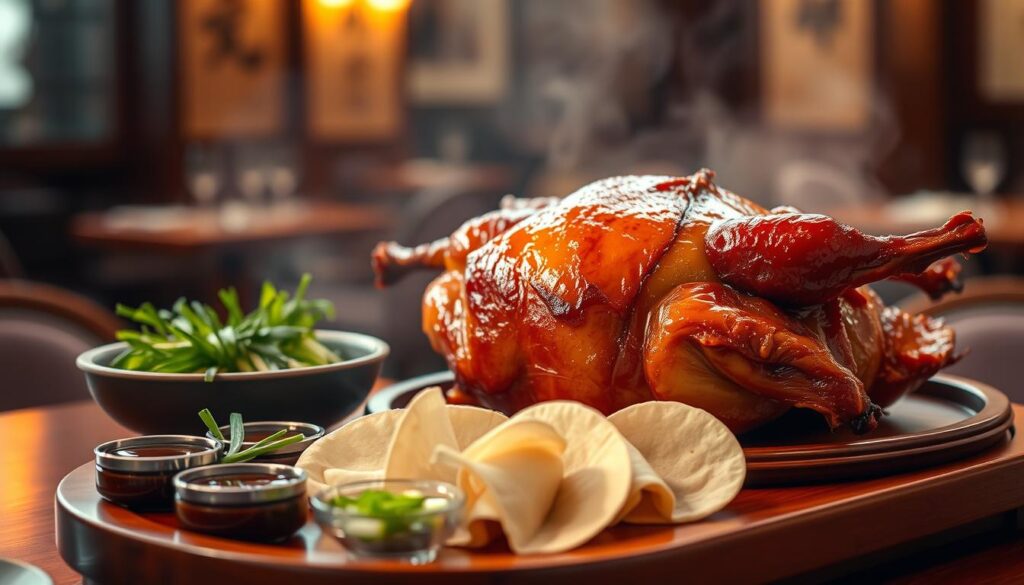
Why Pre-Ordering is Essential
Demand outstrips supply for their 24-hour-roasted duck. Pre-ordering guarantees your portion, especially for half-duck options (ideal for 2–3 people). The chefs use a proprietary air-drying method to lock in crispiness—no soggy skin here.
“Timing is everything. We roast at 220°C precisely 45 minutes to render fat without drying the meat.” — Imperial Treasure’s head chef
Pairing Suggestions
Thin pancakes and hoisin sauce are classic, but try their house-made garlic paste for a punch. Tea pairings cut through richness:
- Jasmine: Floral notes balance the duck’s sweetness.
- Pu-erh: Earthy depth complements smoky flavors.
| Style | Imperial Treasure | Jinghua |
|---|---|---|
| Skin | Glass-crisp, maltose-glazed | Thinner, less caramelized |
| Serving | Tableside carving | Pre-sliced |
| Accompaniments | Pancakes + 3 sauces | Steamed buns only |
For the full experience, gather 4–6 people. A whole duck lets you savor every way—from skin wraps to bone broth. It’s refined Chinese cuisine at its finest.
Killiney Kopitiam: A Taste of Tradition
Since 1919, Killiney Kopitiam has defined Singapore’s breakfast culture. This heritage spot serves kaya toast and kopi the way locals start their day—simple, fast, and full of flavor.
Kaya Toast and Soft-Boiled Eggs
Their signature kaya balances pandan leaf and coconut in a 1:3 ratio for creamy sweetness. Try it two ways: sandwiched between crisp toast or layered on fluffy French toast.
Dip your toast into a mix of soft-boiled eggs and soy sauce—a ritual perfected over decades. Regulars swear by pairing it with kopi brewed with condensed milk for a caramel-like finish.
History of Singapore’s Oldest Coffee Shop
The original outlet preserves its 1920s shopfront, complete with mosaic tiles and wooden stools. Despite expanding to 80+ locations, the flagship maintains strict quality checks.
“We roast our coffee beans daily—just like my grandfather did in 1919.” — Third-generation owner
- Kopi variations: Try “kopi gu you” (butter coffee) for a richer sip.
- Time your visit: Mornings buzz with office workers; afternoons offer quieter moments.
Chinatown Complex Food Centre: Dumplings and More
Steam rises from bamboo baskets as Chinatown Complex buzzes with dumpling masters at work. This sprawling hawker hub is a treasure trove of flavors, where generations-old recipes meet fiery woks. Follow the scent of grilled meats and simmering broth to discover its culinary gems.
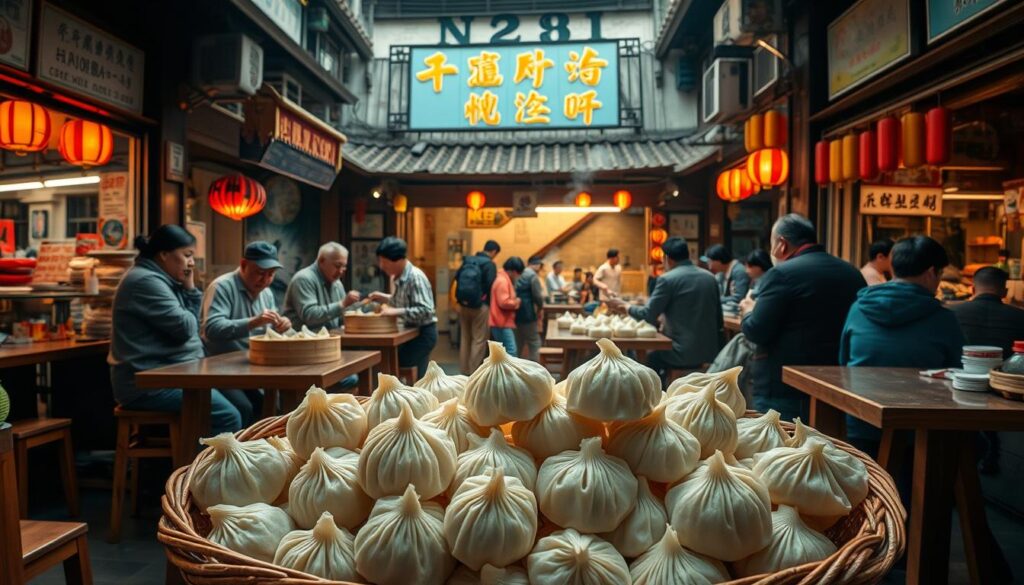
Michelin-Recognized Hawker Stalls
At #02-135, translucent xiao long bao skins hide bursts of pork-filled richness. The secret? A gelatinized broth that liquefies during steaming—a technique perfected over 20 years.
Nearby, Shi Xiang Satay’s skewers glisten with pineapple-infused peanut sauce. Their marinade blends turmeric and lemongrass for 12 hours before charcoal grilling. Pro tip: Order the fatty pork belly skewers for maximum juiciness.
Must-Try Dishes
- Xiao long bao: Thinner skins mean more soup—compare #02-135’s version to adjacent stalls.
- Chili oil wantons: Opt for medium-spicy; the oil’s viscosity clings perfectly to silky wrappers.
- Late-night satay: Post-theater crowds flock here for smoky skewers until 1 AM.
“Our chili paste uses three pepper varieties—it’s about balance, not just heat.” — #02-135’s head chef
For a full experience, arrive before noon. The complex’s 226 stalls offer everything from claypot rice to Nyonya kueh. Each dish tells a story of tradition and innovation.
Labyrinth: Michelin-Starred Singaporean Heritage
Chef LG Han transforms humble local dishes into edible art at this groundbreaking restaurant. Labyrinth reimagines Singapore’s food heritage through modernist techniques while honoring traditional flavors. Every plate tells a story of cultural identity and culinary innovation.
Reinventing Local Classics
The tasting menu features playful riffs like deconstructed kaya toast—crispy brioche with coconut jam espuma. Chili crab appears as delicate foam atop flower crab meat, capturing the dish’s essence in a single bite.
Even laksa gets a makeover with housemade noodles and reduced bisque. Chef Han’s research methodology involves interviewing grandmothers to preserve vanishing recipes before reinterpreting them.
Chef LG Han’s Sustainable Approach
Despite Singapore having just 1% farmland, Labyrinth sources 90% of ingredients locally. The chefs collaborate with urban mushroom farms and use closed-loop systems to minimize waste.
Their cooking philosophy extends beyond the plate. Spent coffee grounds become fertilizer for their herb garden, while fish bones turn into rich stocks.
“We don’t just serve food—we curate memories of Singapore’s past while shaping its culinary future.” — Chef LG Han
This Michelin-starred experience proves that progressive techniques can elevate, not erase, a nation’s cuisine. From the first amuse-bouche to the last petit four, every bite celebrates Singapore’s vibrant food culture.
Maxwell Food Centre: Home of Tian Tian
A culinary landmark since 1954, Maxwell Food Centre balances history with unbeatable flavors. This Chinatown hub is synonymous with chicken rice, but its 100+ stalls offer far more. From sizzling oyster omelets to midnight loh mai gai, every corner tells a story.
![]()
Beyond Chicken Rice: Other Stalls to Explore
Tian Tian’s rival, Ah Tai, trades pandan richness for ginger sharpness—regulars debate which dish reigns supreme. For variety, try these underrated picks:
- Hum Jin Pang: Fry your own youtiao (dough sticks) at this interactive stall.
- Oyster Omelets: Crispy edges with plump oysters at #01-10.
- Loh Mai Gai: Sticky rice bundles steamed in lotus leaves, best paired with herbal soup.
| Feature | Tian Tian | Ah Tai |
|---|---|---|
| Rice Flavor | Pandan-infused | Light ginger |
| Chicken Texture | Silky, poached | Firmer, roasted |
| Queue Time | 30+ mins peak | 15 mins avg |
Best Times to Visit
Most stalls sell out by 2 PM—arrive before 11 AM for the freshest options. Late afternoons (3–5 PM) offer shorter lines but limited menus. Pro tip: Wednesdays are quieter; Tian Tian closes Sundays.
“Maxwell’s charm lies in its chaos. Come hungry, leave with memories.” — Regular diner
Amoy Street Food Centre: Lunchtime Favorites
When the clock strikes noon, Amoy Street transforms into a bustling hub of sizzling woks and steaming baskets. This food haven draws office workers and foodies alike with its mix of heritage dishes and modern twists. From aromatic broths to flaky pastries, every bite tells a story.
A Noodle Story’s Singapore-Style Ramen
Chefs here reinvent ramen with a local touch—think char siew pork and prawn-laced broth. Their signature “tornado shrimp” technique involves flash-frying jumbo prawns into crispy spirals. The dish balances textures:
- Broth: 12-hour reduction with pork bones and dried scallops
- Noodles: Springy alkaline eggs tossed in chili paste
- Toppings: Sous-vide egg with molten center
Arrive by 11:30 AM to beat the lunch rush. The queue moves fast, but the flavors linger.
Curry Puffs and More
J2 Famous Crispy Curry Puff masters the art of layered pastry. Their flaky shells crack open to reveal spiced potato or sardine fillings. The secret? A precise 3:1 dough-to-fat ratio for maximum crispness.
Beyond curry, don’t miss these hidden gems:
- Herbal soups: Slow-simmered with black chicken and goji berries
- Dessert: Ice kachang drizzled with gula melaka syrup
“We roll each puff by hand—that’s the only way to get perfect layers.” — J2’s head baker
Most stalls close by 2 PM, so time your visit wisely. Early birds enjoy the freshest batches, while latecomers risk missing out.
Conclusion: Savoring Singapore’s Culinary Diversity
Every bite in this city tells a story of culture and innovation. From $2 hawker plates to $300 tasting menus, the food scene dazzles with variety. Balance must-try reservations with spontaneous stall discoveries—some gems hide in plain sight.
Time your visits for seasonal highlights like durian feasts or chili crab festivals. Use the MRT’s food maps to navigate efficiently between neighborhoods.
For the freshest tips, follow local bloggers. They reveal hidden cuisine trends and real-time stall updates. Whether you plan meticulously or wander freely, Singapore delivers an unforgettable experience.
Final tip: Chat with vendors. Their stories often make the meal—and show the true way to savor this city.

